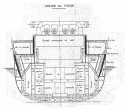broadsword
Brigadier
No. They are focusing on the 003 construction, not on chinese shipbuilding in general.
But Chinese shipbuilding covers all ships.
No. They are focusing on the 003 construction, not on chinese shipbuilding in general.
So, I suggest the next : get a set of LEGO, and try to construct the ship with the method suggested by you ,
IT will be quite obvious it is not possible to do with cranes attached to the ship structure, due to the reasons I described before.
Don't take it as offence, I kept training in the past with LEGO to engineering managers, to explain things like this . (It is not so effective, the best training is the "go down to the shoplfoor and do it" : ) ) .
The shed visibly has a crane , check this :
View attachment 55434
The grey protrusion is the support of the crane rail on both side.
The white dot on the left, and the white line parallel with the shed movement axis is the rail of the crane.
The two strip hanging down is from the crane.
The workflow should be for small parts :
-move the shed beyond the edge of the structure,
-move the parts under the shed
-pick them up and move them to the assembly position
The big crane require do move into position the really big things, like the bulkheads.
And generally, if you check the corners of the modules they are weak, not capable to withstand the torque generated by the very far centre of gravity and relatively central support.
View attachment 55435
Means the modules missing the perpendicular bulkheads (that should make the module rigid and strong enough to carry its own weight ) , means the construction is in the early phases.



Why does the module have a wall in the middle ?
I take it that’s not for the hanger ?
hanger modules will sit on top of that ?
It is the part of the hull, that is below the waterline. It is for machinery spaces, magazines, etc.I take it that’s not for the hanger?

 100 MW
100 MWWe see a ship's hull with engine rooms so big that even 8 boilers and 4 steam turbines would fit into it. What can we think now?
